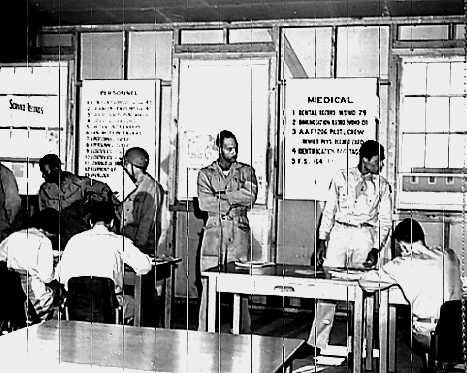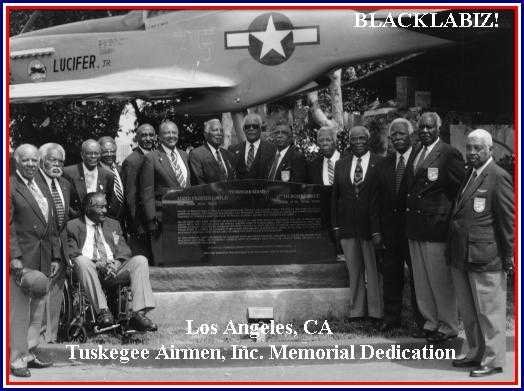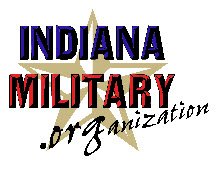|
477th
Bombardment Group |
|
|
The Men
and Their Airplanes: The Bombers Stanley Sandler on page 119
of his book, Segregated Skies: All-Black Combat Squadrons of WW II,
"The 477th Bombardment Group was conceived solely in response to
black pressure, rather than to any perception that black Americans in the
Army Air Forces could make any great contribution to the war effort. And
it remained a paper outfit from its activation in June 1943 until January
1944." [Author's note: Some
sources call the 477th Bombardment Group the 477th Bombardment Group
(Medium) and some sources list them as the 477th Bombardment Group
(Negro).] By late 1944 the 477th was
able to conduct combat training missions, but winter conditions reduced
flying time. When not fighting weather and equipment, the men also faced
racism from white officers and men. Promotions went mainly to the white
officers and enlisted staff while black promotions were limited. In March,
1945 the 477th was moved to Freeman Field, Indiana. Tension between white
and black personnel increased. Part of the problem of the 477th lay in its
white base commander, Colonel Robert Selway whose strict segregationist
policies hurt morale and led to the Freeman Field incident on April 5,
1944. The 477th's contribution
was not in its combat record. Ultimately the Freeman Field incident opened
the door to the eventual desegregation of the USAAF. As Sandler notes on
page 131, "The 477th, although lingering on as a unit until 1947,
never saw combat. It scored no "kills", blasted no enemy
positions, bombed no alien cities. But it had its victories. The 477th Bombardment Group
became the 477th Composite Group with B-25's and P-47's and trained for a
possible role in the Pacific Theater. The war ended, however, before the
477th could be deployed overseas in a combat role. The aircraft the 477th flew in training was the B-25 Mitchell medium bomber. This workhorse was used in both the European and Pacific Theaters. Variations of it included models with up to thirteen fifty caliber machine guns or a seventy-five (75 mm) cannon for anti-ship missions in the Pacific.
A
version of this information appeared in the Summer 1993 issue of the IHS's
popular history magazine In January 1945 the
American effort in World War II was reaching a climax. GIs in Europe had
turned back the last German offensive on the western front at the Battle
of the Bulge, and in the Pacific Theater United States troops were
recapturing the Philippines from the Japanese. While military operations
were reaching a fever pitch overseas, back home in Indiana activity was
winding down at a military installation that had awarded wings to
approximately four thousand airmen: Freeman Field, located near Seymour.
Although the U.S. War Department had placed the installation on an
inactive basis on Jan. 27, 1945, the air base would soon be a proving
ground in a different struggle, not against fascism on the battlefront,
but against racism on the home front. Denied access to the base's
officers club on account of their race, approximately sixty officers from
the all-black 477th Bombardment Group, which was receiving bomber training
at Freeman Field, were arrested on April 3, 1945, when they attempted to
enter what the Indianapolis Recorder referred to as a "swanky
and modern officers club set up by order of Colonel Robert R. Selway, Jr.,
commander of the outfit." After the dust had settled, three
officers--Roger C. Terry and Marsden A. Thompson, both of Los Angeles, and
Shirley R. Clinton of Camden, N.J.--faced a court-martial, and
approximately 100 men from the air group (including current Detroit Mayor
Coleman Young) were jailed at Godman Field in Kentucky. The calm atmosphere of a
small Civil Aeronautics Administration (CAA) emergency field, located
southwest of Seymour, changed following the Japanese attack on Pearl
Harbor, which plunged the United States into war. On May 6, 1942, the War
Department announced that the Seymour CAA field had been selected as a
site for an advanced aerial training center for bomber pilots, to be
designated as Seymour Army Airfield. The base, which was renamed Freeman
Army Airfield on March 3, 1943, in honor of the late Capt. Richard S.
Freeman of Winamac, Indiana, included more than 400 buildings and was
built at a cost of approximately $15 million. The 2,550-acre facility the
federal government created in Jackson County was "the epitome of
military airfield design," according to Louis Osterman in his 1986
history of the base. The installation had an immediate financial impact on
a community still reeling from the Great Depression. Officially activated on
Dec. 1, 1942, under the command of Col. Elmer T. Rundquist, the air base
welcomed its first group of soldiers just seven days later. The added
population proved to be a boon for area businesses. "The stores were
open on Saturday night then, and the sidewalks were packed from curb to
store with townspeople, the farmers of the area and their families, and
soldiers in their wool, khaki uniforms and jaunty overseas caps,"
Seymour resident Carolyn Mahon told Osterman. To help meet the soldiers'
recreational needs, the city had been planning, even before the first
troops reached the base, to open a United Service Organization (USO)
center. It organized a U. S. O Council and obtained the use of the former
Greeman Furniture Store. The club opened in December 1942 and was the
scene of a number of dances and other activities for soldiers. The club,
however, did not provide services to all military personnel stationed at
the air base. On Jan. 21, 1943 the first
members of the black 320th Aviation Squadron arrived at the Seymour
installation. The some 600 squadron members were used primarily as service
troops, performing such duties as cooking in the mess hall and tending the
base's 20-acre garden. Segregation in the armed
forces during World War II was widespread. In fact, it wasn't until
January 1941, after pressure from the National Association for the
Advancement of Colored People (NAACP) and other groups, that the Army Air
Force (AAF) allowed blacks to become pilots. After being threatened with a
lawsuit, the War Department established an air unit (later known as the
99th Pursuit Squadron) for African-Americans near Tuskegee Institute,
Alabama. The Tuskegee Army Air Field, however, was completely segregated
at the outset, with fliers under the command of and trained by white
officers. Opportunities for blacks in
this state at the start of World War II were little better than those
offered by the Army. "It was nearly impossible to find in Indiana a
public place, institution, or group where whites accorded blacks an equal
and open reception," noted Indiana University Professor of History
James Madison in his history of the state from 1920 to 1945. Although
there were no actual statutes on the books, in many towns blacks
encountered so-called "Sundown laws," which forbade them to stay
in the city after dark In most aspects of their daily lives, from eating
in restaurants to watching motion pictures, African-American Hoosiers
faced discrimination and segregation. Jackson County was no
different from any other Indiana community in the 1940s "in that
segregating and insensitivity to civil rights issues were accepted facts
of life," noted Osterman. Because black troops stationed at the
airfield could not use the white USO club in Seymour, the USO Council
established a separate facility for them on West Tipton Street, which was
dedicated on Feb. 14, 1943, in ceremonies held inside the center because
of severe weather. Rev. John L. Prentice, Jackson County USO Council
chairman, formally presented the club to the city "as a channel of
service for the citizens." Segregation continued to be
a problem for the next black troops stationed at the Seymour base, the
477th Bombardment Group, which was part of the First Air Force. Under the
command of a white officer, Colonel Selway, a West Point graduate and Far
East veteran, the unit "had traveled a rocky road since its
activation in January 1944," according to then Colonel Benjamin O.
Davis, Jr. The first black graduate of the U.S. Military Academy in this
century and a member of the famed Tuskegee Airmen, Davis took charge of
the 477th during the height of the Freeman Field controversy. The first black squadron to
be trained for service in multi-engine airplanes, the 477th was originally
stationed at Selfridge Field, located near Detroit. The field had a
history of racial conflict. On Jan. 1, 1944, some black officers who had
attempted to enter the base's officers' club were blocked by commander
Colonel William L. Boyd and a second officer. This blockage flew in the
face of the armed force's own rules, specifically Army Regulation (AR)
210-10. According to that ruling, officers' clubs and other social
organizations were mandated to offer "all officers on duty at the
post the right to full membership, either permanent or temporary."
Alan Osur, who studied race relations in the AAF during World War II
found, however, that the military organization had "dogmatically
pursued a system of segregation that was almost impossible to maintain. It
even went so far as to violate War Department regulations in order to
prevent the mixing of whites and blacks in officers' clubs." Afraid that black
"agitators" in the Detroit area might incite trouble with the
Selfridge Field airmen (race riots had broken out in the city in June
1943), the AAF moved the 477th to Godman Field near Fort Knox, Kentucky.
At the new airfield, black officers were able to enjoy full use of the
officers' club. Racial relations, however, were not as promising as they
seemed. While blacks used the officers' club at Godman, their white
supervisors used the facilities at the segregated Fort Knox. Osur points
out that black airmen were powerless to protest the situation; since they
were not assigned to Fort Knox, they could not use its facilities. Other problems plagued the
black fliers at the Kentucky AAF base. Along with bad flying weather
during the winter, the field suffered from a lack of proper hangar and
apron space and an air-to-ground gunnery range. On March 1, 1945, the
477th moved from Godman to Indiana's Freeman Field. Trouble, however, soon
broke out between blacks and whites. The difficulties weren't with Seymour
residents, who, according to AAF Captain Earl D. Lyon in his study of the
bombardment group's war service, "were less openly antagonistic"
to black officers than residents of similar small towns located near Army
airfields. Instead, the racial trouble broke out on the base over a
familiar issue--the officers' club. In attempting to keep black
and white officers from using the same facilities, Colonel Selway, with
the support of AAF Major General Frank Hunter, took advantage of a
loophole in AR 210-10 by designating one officers' club at Freeman for
supervisory personnel and a second one for trainees, which resulted, as
Osur points out, in "de facto segregation." The issue came to a
head on the night of April 5, 1945, when 19 black officers, disregarding
an assistant provost marshal's orders to leave, entered the whites-only
club. Shortly afterwards, two other groups of blacks totaling 17 officers
joined the original group; all 36 were put under arrest by the provost
marshal. The next day, an additional 21 African-American officers were
arrested when they tried to enter the club. Freeman Field command,
through its public relations office, attempted to put its own spin on the
issue. It issued a statement to the Seymour Daily Tribune to the
effect that in the case of recreational facilities, it had "been a
long standing policy which applies throughout the United States which
maintains that it is unwise to have personnel in training utilizing the
same recreational facilities with those who train them." Even though
the two groups might use the same instructional facilities--classrooms,
training equipment, airplanes, ranges, etc.--after normal duty hours
"each . . . selects its own recreation and entertainment separately,
in order that they may relax from their official status." Despite the air base's best
efforts, the outcry over the incident would not die down. First Air Force
legal officers were soon on their way to Freeman Field to investigate the
matter. They found that Selway's original order was "inexact and
ambiguous as to its meaning or purpose," and all but three of the
black officers were released. (Lieutenants Clinton, Terry, and Thompson
were still under lock and key for allegedly pushing the provost marshal
when the entered the club.) A new directive from base commander Selway,
however, would spark more protests and lead to even more arrests. Selway, with General
Hunter's help, drafted an order for black officers to sign outlining what
facilities different personnel could use on the base. The directive also
included a place for the black officers' signatures indicating that they
had read and fully understood the order. Even when that designation was
stricken from the order, and the black officers were asked merely to
signify that they had read it, some continued to defy the authorities. A
total of 101 blacks--who became known as the 101 Club--refused to sign and
were flown back to Godman Field and placed under arrest awaiting
court-martial. Quentin P. Smith, who grew
up in East Chicago, Indiana, and learned to fly while living there, was
one of the 101 black officers arrested for not signing the order. An
Indiana State University graduate and former flying instructor at Tuskegee
Institute, Smith, due to his large size, had to transfer from fighter to
bomber duty. First Lieutenant Smith and the other black aviators did not
receive a warm welcome when they arrived at Freeman Field. Smith
remembered Colonel Selway informing the group that, along with the
officers' club, the base's tennis court and swimming pool were also off
limits to them. The announcement was not greeted favorably by the airmen:
"We booed the colonel loud and long," Smith said. The Hoosier native had a
more direct confrontation with the colonel after the officers' club
incident. Called into Selway's office and asked to sign the new directive,
Smith replied in a clear voice, "No, sir." Even when he was
threatened by the colonel with Article 64, which states that failure to
obey a superior officer's direct order could result in the death penalty,
Smith stood firm. In an oral history interview with Indiana Historical
Society Editor Doug Clanin, Smith remembered: "The immediate
major said, 'I order you to sign.' I didn't have any breath, I didn't have
any saliva left to say anything . . . I shook my head because I couldn't
even talk. So I said, 'no' [in high voice]. He rapped a gavel and said,
'you go out that door.' When I went out that door a soldier said, 'Go back
to your barracks, don't put your head out, don't come out, when suppertime
comes, we'll bring you your food.' So I'm sitting there by myself
thinking, 'now this just can't be true. I'm just about 190 miles from home
and this just can't be happening.' But it was. Organizations throughout
the United States, including the NAACP and black newspapers, swung into
action on the officers' behalf. The War Department received several
letters of concern from lawmakers, including Michigan Senator Arthur H.
Vandenberg, New York Congressman Adam Clayton Powell, and Indiana
Congressman Louis Ludlow. California Congresswoman Helen Gahagan (who
would be defeated for re-election after the war by Richard Nixon) even
telegraphed Secretary of War Henry L. Stimson urging that the officers be
released. These efforts paid off; in mid-April charges against the 101
black officers were dropped and the men were freed. Charges against the three
officers accused of pushing the provost marshal, however, remained in
effect. By the time the three came to trial, the 477th had a new
commander, Colonel Davis, former leader of the black 332d Fighter Group.
An all-black court-martial acquitted Thompson and Clinton of all charges,
convicting only Terry for "offering violence against a superior
officer." He was fined $150. The entire Freeman Field
situation deeply troubled Colonel Davis. Although he could understand the
underlying feelings of prejudice shown by officers from the Deep South, he
could not understand "putting the issue of segregated facilities
ahead of the need to prepare the group for war; nor the decisions to move
the 477th from one airfield to another, which halted progress toward
combat readiness for several months." The 477th never had the
opportunity to prove itself in combat, as the group was still at Godman
Field when the Japanese surrendered to the Allies on Aug. 14, 1945. Although Freeman Field was
once again put on an inactive basis shortly after the officers' club
fiasco, its role in America's war effort wasn't finished yet. In June 1945
the War Department selected the base to serve as a testing ground for
captured enemy aircraft. Once again airplanes filled the skies over
Seymour. Two years later, the War Assets Administration gave the facility
to Seymour, which used the base as a municipal airport. Despite its crucial role in
training aircrews for combat, perhaps Freeman's greatest contribution to
America's fight against fascism was the incident with the black officers,
which, as Osterman points out, "caught the attention of the military
and forced a re-thinking of its policy of segregation." |
|







 Page
last revised 10/18/2020
Page
last revised 10/18/2020